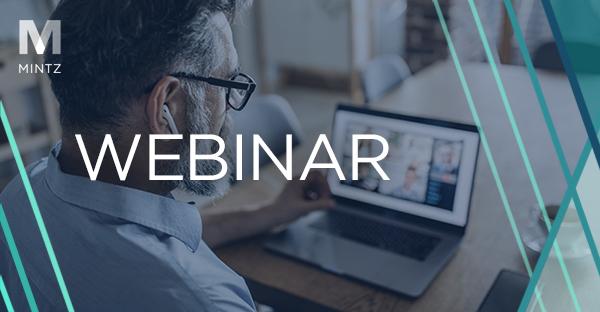
COVID-19 Viewpoints
Filter by:
How to Handle Religious Objections to a Workplace Vaccine Mandate
September 2, 2021 | Blog | By Jennifer Rubin
Employers implementing mandatory Covid-19 vaccination programs must manage, and in some cases accommodate, exemption requests. Legal exemptions from mandatory vaccination include medical exemptions under the Americans with Disabilities Act and exemptions based on sincerely held religious beliefs pursuant to Title VII of the Civil Rights Act of 1964 (and equivalent state laws for both federal statutes).
Read more
Masks Off, Masks On - Now What?
July 28, 2021 | Blog | By Jennifer Rubin
CDC’s updated guidance suggesting facial coverings be worn in “public indoor settings” adds a new but hopefully surmountable barrier to returning the workforce to the office (though undefined, we presume this means any indoor location where two or more individuals are working). At the outset, the CDC guidance does not create a Federal workplace mandate but rather provides a baseline for the creation of safety standards grounded in scientific data – data we recognize is not static given the nature of the Coronavirus pandemic. The latest guidance has frustrated some employers who are attempting to develop sensible policies to return their workforce to offices. We offer some practical guidance regarding the changes, if any, employers might consider in response to the latest CDC guidance.
Read more
NY HERO Act Standards & Template Policies Released – Employer Action Required
July 8, 2021 | Blog | By Corbin Carter, Michael Arnold
The New York State Department of Labor (NYSDOL) has released its HERO Act minimum standards and template policies related to airborne infectious disease prevention. Employers now have 30 days after the standards’ publication – until August 5, 2021 – to either: (1) adopt one of the model standard exposure prevention plans applicable to their industry, or (2) develop and establish an alternative prevention plan that meets or exceeds the minimum standards.
Read more
Return to the Office – Mandatory Vaccinations
June 22, 2021 | Video | By Jennifer Rubin
In this video, Mintz Employment Member, Jen Rubin, discusses a few important issues employers need to know with respect to vaccination programs.
Read more
Return to the Office – Returning to the Basics
June 21, 2021 | Video | By Jennifer Rubin
Whether or not a business has returned fully to a physical workplace, partially with a hybrid arrangement, or has remained remote, there are a few key areas of focus for a successful return. In this video, Mintz Employment Member, Jen Rubin, highlights important issues employers should consider.
Read more
Third Time’s the Charm: Cal/OSHA’s Revised COVID-19 Prevention Emergency Temporary Standards (ETS) Is Effective Immediately
June 18, 2021 | Blog | By Jennifer Rubin
Cal/OSHA has approved revised Emergency Temporary Standards (ETS) and Governor Newsom has issued an executive order waiving the usual 10-day legal review and approval process by the Office of Administrative Law (OAL). This revised ETS (the third version since late May) more closely aligns with the CDC and California Department of Public Health (CDPH) guidelines on face covering restrictions and physical distancing.
Read more
Webinar Recording: Vaccination and the Workplace – Solving for the Latest Challenges Facing Employers
June 17, 2021 | Webinar | By Michael Arnold, Geri Haight, Jennifer Rubin, Corbin Carter
The CDC’s latest guidance lifting many restrictions for most fully vaccinated individuals has forced employers to consider whether and how to implement workplace vaccination policies. During this webinar, our speakers explored the current workplace vaccine compliance landscape and offered best practices for implementing vaccination policies aimed at making workplaces safe and while accounting for jurisdictional, political, philosophical and physical divides.
Read more
Return to the Office – Employer Considerations (Part 1)
June 15, 2021 | Video | By Jennifer Rubin
Now that widespread vaccination appears to be slowing the pandemic, and in light of the CDC’s guidance regarding measures fully vaccinated individuals can take, returning to the office has become a priority for employers across the nation. In this video, Mintz Employment Member, Jen Rubin, discusses some concepts employers should consider as they plan to return employees to the office.
Read more
ALERT: New York Hits Key 70% Vaccination Metric; Reopening Rules Lifted
June 15, 2021 | Blog | By Corbin Carter, Michael Arnold
It’s been a long road to recovery for employers since New York first issued its NY Forward reopening requirements for offices and other similar environments back in May 2020. Today, as New York reached a key vaccination metric – 70% of adults have now received at least one vaccine shot – Governor Cuomo announced that New York businesses will no longer be required to abide by the current industry-specific guidelines in order to reopen. Accordingly, the current NY Forward guidelines on capacity restrictions, social distancing, cleaning and disinfection, health screenings, contact tracing, and other virus-related restrictions are now lifted in most commercial settings.
Read more
New York Revises COVID-19 Reopening Guidance & HERO Act Changes on the Way
June 10, 2021 | Blog | By Corbin Carter, Michael Arnold
It’s been a busy month (year?) for New York employers – one that has brought several important updates with respect to employers’ reopening plans. On the heels of the State’s May 19th adoption of the recent CDC guidance outlining increased privileges for fully vaccinated individuals, New York State updated its NY Forward COVID-19 reopening guidance on June 8, 2021, including its guidance geared toward office environments. As a reminder, New York businesses opting to reopen during the COVID-19 pandemic must do so consistent with the State’s industry-specific reopening guidelines, found here; affirm their compliance with same prior to reestablishing in-person operations; and implement a written safety plan governing its workplace safety protocols.
Read more
Cal/OSHA Approves Minor Modifications to COVID-19 Prevention Emergency Temporary Standards (ETS)
June 8, 2021 | Blog | By Jennifer Rubin
Cal/OSHA has relaxed some of its COVID-19 Prevention Emergency Temporary Standards (ETS) for fully vaccinated individuals to better align with the California’s June 15, 2021 goal to end most mask and physical distancing requirements. But the proposed revisions stop short of fully adopting the May 13, 2021 CDC guidance for fully vaccinated individuals and do not (yet) provide guidance on several important issues, including the enforcement of documentation for vaccine verification and how employers can demonstrate that physical distancing is not feasible.
Read more
Massachusetts COVID-19 Emergency Paid Sick Leave
June 7, 2021 | Blog | By Andrew Matzkin, Natalie C. Groot
Massachusetts Governor Charlie Baker recently signed legislation requiring employers to provide COVID-19 emergency paid sick leave (“COVID-19 EPSL”) to employees who are unable to work for COVID-19-related reasons. In this post, we summarize and answer some frequently asked questions.
Read more
New York State’s HERO Act Imposes New Workplace Health and Safety Obligations on Employers
May 19, 2021 | Blog | By Corbin Carter, Michael Arnold
The New York State Legislature recently passed the Health and Essential Rights Act (the “HERO Act”), which has been delivered to Governor Cuomo for his signature. The legislation seeks to address continued COVID-19 safety concerns in the workplace and is designed to codify, supplement, and replace numerous executive actions that have been issued throughout the pandemic. The HERO Act would also pass into law significant new health and safety obligations for New York employers, including the formation of joint labor-management workplace safety committees to help ensure worker safety. Employers should prepare now to come into compliance with the new law, which we summarize below.
Read more
Have You Been Vaccinated? Your Employer (and Everyone Else) Wants to Know
May 17, 2021 | Blog | By Jennifer Rubin, Michael Arnold
The CDC’s recent guidance suggesting that most fully vaccinated individuals may discontinue certain safety measures, such as masking and social distancing, has created significant confusion for employers navigating conflicting and ever-changing state and local COVID-19 workplace laws, regulations and guidance. While the most recent CDC guidance endorses resuming activities (indoors and out) without masks for most fully vaccinated individuals, the guidance around vaccination verification and disparate treatment between the vaccinated and unvaccinated is still lacking. Employers are now facing these sensitive but critically important return to office issues without the benefit of critical guidance from Federal, state and local regulators. We provide some guidance below regarding vaccine verification and some considerations for employers thinking about instituting vaccine policies.
Read more
CDC Vaccination Guidance Does Not Supersede State and Local Workplace Regulations
May 14, 2021 | Blog | By Danielle Bereznay, Jennifer Rubin, Michael Arnold, Corbin Carter
On May 13, 2021, the Centers for Disease Control and Prevention (the “CDC”) published guidance indicating that fully vaccinated individuals do not need to wear a mask or physically distance in certain indoor and outdoor environments, except where otherwise required by federal, state, local, tribal, or territorial laws, rules, and regulations, including local business and workplace guidance. The guidance does not apply to healthcare settings and certain other environments.
Read more
ALERT: New COVID-19 Vaccine Paid Leave for New York Employees
March 16, 2021 | Blog | By Corbin Carter
As we enter the second year of the COVID-19 pandemic, New York employers must now grapple with another new paid leave requirement from New York State. A new law signed by Governor Cuomo on March 12, 2021 amends New York’s Labor Law and entitles employees up to four hours of paid leave per COVID-19 vaccine injection. The law is effective immediately, and the law’s leave entitlement is set to expire on December 31, 2022. We note key provisions of the new law below.
Read more
Conference Recordings: Mintz's Annual Employment Law Summit
March 12, 2021 | Webinar | By Michael Arnold, David Barmak, Micha Mitch Danzig, Geri Haight, Andrew Matzkin, David Lagasse, Jennifer Rubin, Alexander Hecht, Danielle Bereznay, Delaney Busch, Corbin Carter, Emma Follansbee, Natalie C. Groot, Paul Huston, Brendan Lowd, Nicole Rivers, Richard Block
Mintz’s Annual Employment Law Summit brought together thought leaders to discuss the most pressing issues employers are facing in today’s unprecedented work environment. Attendees heard presentations on the continued impact of COVID-19; social justice and diversity, equity and inclusion initiatives; recent and anticipated changes to employment laws; and best practices for managing sensitive employee situations.
Read more
Agencies Issue Needed Guidance on COBRA Elections During the COVID-19 “Outbreak Period”
March 3, 2021 | Blog
On February 26, 2021, the Department of Labor’s Employee Benefits Security Administration (EBSA) issued Notice 2021-01 (the “Notice”). The Notice was issued jointly with the Department of the Treasury, the Internal Revenue Service and the Department of Health and Human Services (the “Departments”). Entitled “Guidance on Continuation of Relief for Employee Benefit Plans and Plan Participants and Beneficiaries Due to the COVID-19 (Novel Coronavirus) Outbreak,” the Notice provides much needed guidance to group health plan sponsors on (among other things) when COBRA notice and election periods, which had been previously extended [in May 2020], will come to an end. This guidance was necessary because earlier regulatory relief extending COBRA notice and election periods was about to expire as a result of a statutory deadline. This post explains the impact of the Notice on sponsors of group health plans.
Read more
Navigating Voluntary COVID-19 Vaccination Programs & Incentives
February 19, 2021 | Blog | By Corbin Carter
As COVID-19 vaccines become more available, employment-based programs requiring or incentivizing employee vaccination will become more commonplace. In a previous post, we covered recent employer guidance from the CDC, with a particular focus on mandatory workplace testing programs. This post examines how an employer might design a voluntary workplace vaccination program using incentives to encourage participation, and how to avoid potential pitfalls in doing so.
Read more
CDC Issues Expanded Guidance for Workplace COVID-19 Testing Programs
February 5, 2021 | Blog | By Danielle Bereznay, Michael Arnold
The CDC has issued new guidance focused on ensuring employees’ informed consent for COVID-19 testing in the workplace. This builds on earlier guidance the CDC issued regarding workplace testing programs last fall. Because the CDC notes that employers should not conduct testing without an employee’s informed consent, employers should be prepared to answer employee questions and concerns by utilizing the recommend framework discussed below.
Read more




